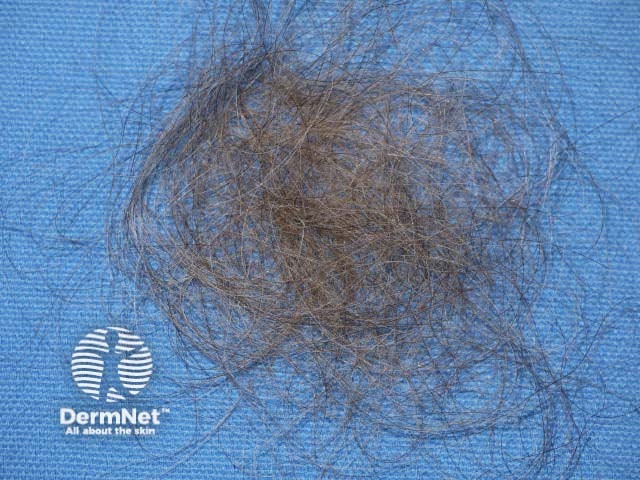Main menu
Common skin conditions

NEWS
Join DermNet PRO
Read more
Quick links
Created 1997. Updated by Dr Fen-Lan Cherry Chang, House Officer, Middlemore Hospital, Auckland, New Zealand. DermNet Editor in Chief: Adjunct Assoc. Prof. Amanda Oakley, Dermatologist, Hamilton, New Zealand. November 2019.
Introduction
Demographics
Causes
Clinical features
Diagnosis
Differential diagnoses
Treatment
Outcome
Telogen effluvium is the name for a common cause of temporary hair loss due to the excessive shedding of resting or telogen hair after some shock to the system. New hair continues to grow. Telogen hair is also known as a club hair due to the shape of the root.
It should be distinguished from anagen effluvium, in which the hair shedding is due to interruption of active or anagen hair growth by drugs, toxins or inflammation (eg, alopecia areata). Anagen hair has a pointed or tapered tip.

Telogen effluvium

Telogen effluvium

Hair shedding
Acute telogen effluvium can affect people of all age groups and both sexes. Chronic telogen effluvium with no clear precipitating cause tends to present in otherwise healthy women 30–60 years of age.
In a normal healthy person's scalp, about 85% of the hair follicles are actively growing hair (anagen hair) and about 15% are resting hair (telogen hair). A few hairs may also be in catagen. A hair follicle usually grows anagen hair for 4 years or so, then rests for about 4 months. A new anagen hair begins to grow under the resting telogen hair and pushes it out.
Thus, it is normal to lose up to about 100 hairs a day on one's comb, brush, in the basin or on the pillow, as a result of the normal scalp hair cycle.
If there is some shock to the system, as many as 70% of the anagen hairs can be precipitated into telogen, thus reversing the usual ratio. Typical triggers include:
Telogen effluvium is a non-scarring form of diffuse hair loss with no clinical or histological evidence of inflammation and can affect up to 50% of the scalp hair.
The resting scalp club hairs remain firmly attached to the hair follicles at first. The new hairs coming up through the scalp push out the resting club hairs and increased hair fall is noticed 2 to 4 months after the triggering event.
Thus, paradoxically, with this type of hair loss, hair fall is a sign of hair regrowth.
Because nail and hair growth are under the same influences, an arrest in hair growth is often mirrored in the nails by a groove across them coinciding with the time of the shock to the system — a Beau line. The time of the shock can be estimated from the fact that a fingernail takes 5 months to grow from the posterior nail fold to the free edge. So if the groove in the nail is halfway down the nail, the shock must have been two and a half months ago.

Beau line

Beau line

Beau line
In some patients, hair shedding continues to be intermittently or continuously greater than normal for long periods of time, sometimes for years. The hair cycle appears to be reset so that the anagen period is shortened.
Chronic telogen effluvium often presents in women that actually continue to have quite thick and moderately long hair – this is because they notice the shed hair more than those with finer or shorter hair. Telogen effluvium does not cause complete baldness, although it may unmask a genetic tendency to genetic balding i.e. female pattern hair loss, or in men, male pattern hair loss.
The mechanism of chronic telogen effluvium is not well understood. Middle-aged women with a long fluctuating course of telogen effluvium, producing widespread thinning lasting many years have normal hormonal studies.
Telogen effluvium is usually diagnosed by its clinical features.
A trichogram can help confirm the diagnosis; more than 25% telogen hairs in a trichogram strongly suggests telogen effluvium.
Light microscopic examination shows club hair
A scalp biopsy is rarely needed; it is expected to show normal terminal/vellus hair ratio, an increased number of telogen follicles, and little to no inflammation and fibrosis.
Other forms of hair loss that should be considered include:
Telogen effluvium is self-correcting. Recommendations include:
The psychological effects of hair loss should not be ignored.
Regrowth usually occurs after removal of the trigger causing telogen effluvium. However, repeated episodes of acute telogen effluvium can sometimes evolve into female pattern hair loss.